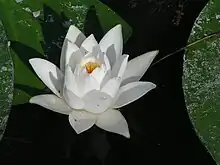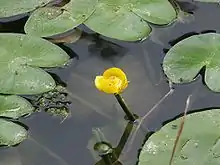nenuphar
See also: nénuphar
English

Nymphaea alba

Nuphar lutea
Etymology
From Medieval Latin nenuphar, from Arabic نِلُوفَر (nilūfar), نِينُوفَر (nīnūfar), from Middle Persian nylw(k)pl (nīlōpal, “lotus, water-lily”), from Sanskrit नीलोत्पल (nīlotpala), from नील (nīla, “blue”) + उत्पल (utpala, “lotus, water-lily”). Compare French nénufar.
Pronunciation
- IPA(key): /ˈnɛnjʊfɑː/
Noun
nenuphar (plural nenuphars)
- A water lily, especially the European white water lily (Nymphaea alba) or the yellow water lily (Nuphar lutea).
- 1920, Natalie Clifford Barney, “A Parisian Roof Garden in 1918”, in Poems & poèmes:
- We'll try the «lunar waltz» while floats afar / Upon the liquid night — night's nenuphar.
- 1923, Powys Mathers, transl., The Thousand Nights and One Night:
- Arrived at the stall of a fruiterer, she bought Syrian apples, Osmāni quinces, peaches from Uman, jasmine of Aleppo, Damascene nenuphars, cucumbers from the Nile, limes from Egypt, Sultānī citrons, myrtle berries, flowers of henna, blood-red anemones, violets, pomegranate bloom, and the narcissus.
- 1962, Vladimir Nabokov, Pale Fire:
- Somewhere an iron curtain had gone up, baring a painted one, with nymphs and nenuphars.
Further reading
 Nuphar on Wikispecies.Wikispecies
Nuphar on Wikispecies.Wikispecies
This article is issued from Wiktionary. The text is licensed under Creative Commons - Attribution - Sharealike. Additional terms may apply for the media files.